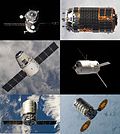 HTV-4 being grappled by the SSRMS on 9 August 2013 | |
| Mission type | ISS resupply |
|---|---|
| Operator | JAXA |
| COSPAR ID | 2013-040A |
| SATCAT no. | 39221 |
| Mission duration | 35 days |
| Spacecraft properties | |
| Spacecraft type | H-II Transfer Vehicle (HTV) |
| Manufacturer | Mitsubishi Heavy Industries (MHI) |
| Launch mass | 15900 kg |
| Dry mass | 10500 kg |
| Start of mission | |
| Launch date | 3 August 2013, 19:48:46 UTC |
| Rocket | H-IIB No. 4 |
| Launch site | Tanegashima, Yoshinobu-2 |
| Contractor | Mitsubishi Heavy Industries |
| End of mission | |
| Disposal | Deorbited |
| Decay date | 7 September 2013, 06:37 UTC |
| Orbital parameters | |
| Reference system | Geocentric orbit [1] |
| Regime | Low Earth orbit |
| Inclination | 51.66° |
| Berthing at ISS | |
| Berthing port | Harmony |
| RMS capture | 9 August 2013, 11:22 UTC |
| Berthing date | 9 August 2013, 15:28 UTC |
| Unberthing date | 4 September 2013, 12:07 UTC |
| RMS release | 4 September 2013, 16:20 UTC |
| Time berthed | 25 days, 20 hours, 29 minutes |
| Cargo | |
| Mass | 5400 kg |
| Pressurised | 3900 kg |
| Unpressurised | 1500 kg |
Kounotori 4, also known as HTV-4, was the fourth flight of the H-II Transfer Vehicle, an uncrewed cargo spacecraft launched in August 2013 to resupply the International Space Station. It launched from Tanegashima Space Center aboard H-IIB No. 4 (H-IIB F4) rocket on 3 August 2013 and connected to ISS by 9 August 2013; it carried 5,400 kilograms (11,900 lb) of cargo. [2] Kounotori 4 undocked on 4 September 2013 and was destroyed by reentry on 7 September 2013. [3] [4]

